Overview
The discussion centers on nine fire-resistant battery technologies that significantly enhance energy storage safety. These include:
- Solid-state
- Lithium iron phosphate (LFP)
- Nickel manganese cobalt (NMC)
- Graphene-based batteries
The pressing issue of energy storage safety is addressed through these innovations, which markedly reduce risks such as thermal runaway and overheating. Advancements in thermal stability and innovative thermal management systems underscore their importance, positioning these technologies as essential for safe and efficient energy storage solutions. The benefits of implementing these technologies are clear, making them a crucial consideration for stakeholders in the energy sector.
Introduction
Fire safety in energy storage has reached a pivotal moment as the demand for reliable power solutions escalates. With significant advancements in fire-resistant battery technologies, the energy storage landscape is transitioning toward safer, more efficient alternatives that aim to mitigate the risks associated with conventional systems. As both industries and consumers strive to leverage the advantages of these innovative technologies, a pressing question emerges: which fire-resistant battery solutions excel in enhancing safety without sacrificing performance? This article explores nine groundbreaking battery technologies that are transforming energy storage safety, examining their distinct advantages and the challenges they encounter in a swiftly evolving market.
Harbinger Land | Advanced Title Research Solutions for Energy Storage Projects
Harbinger Land delivers advanced title research solutions tailored specifically for power retention projects. The complexities of land acquisition, including legal and regulatory challenges, can be daunting. By leveraging AI-powered title research software alongside our GIS mapping services, we ensure compliance with all legal requirements, effectively minimizing the risks associated with land acquisition.
Our GIS mapping capabilities provide enhanced visibility into every aspect of your projects. This integration of real-time data allows for efficient decision-making, enabling clients to swiftly assess potential issues and opportunities. Consider how this knowledge is vital for developers; it allows them to focus on project implementation while ensuring adherence to regulations and optimizing schedules.
With our rigorous quality control processes and in-depth title research methodologies, Harbinger Land empowers clients to confidently acquire land rights and assets in their areas of interest. Are you ready to streamline your land acquisition process? Let us help you navigate the complexities and achieve your project goals with confidence.
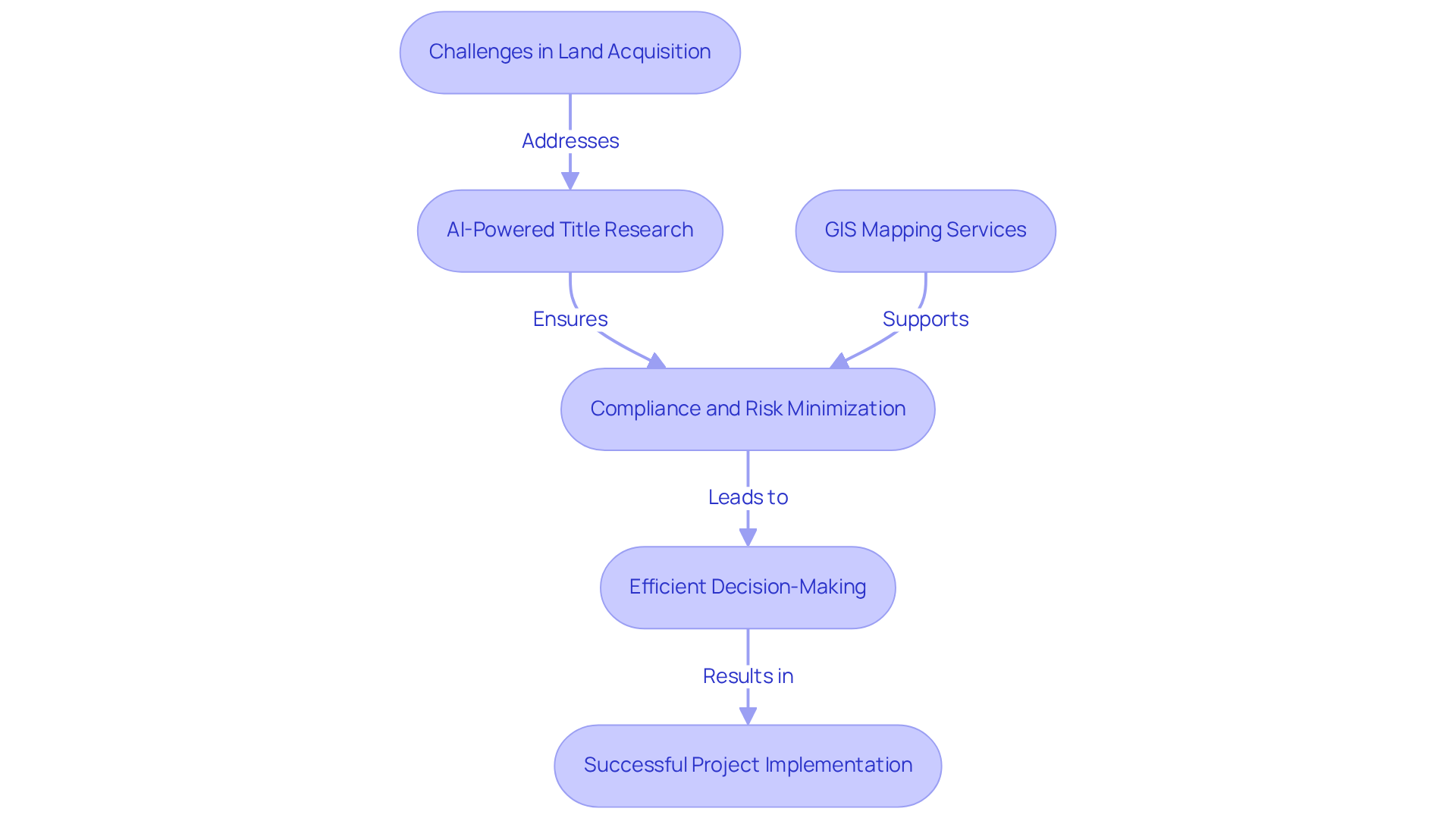
Solid-State Batteries: Enhanced Safety and Energy Density
Solid-state energy storage devices utilize fire-resistant battery technologies by incorporating a solid electrolyte instead of a liquid alternative, significantly reducing the risk of leaks and fires. This enhancement in safety, coupled with increased power density, positions them as an attractive option for power retention applications. Fire-resistant battery technologies operate effectively at elevated temperatures and exhibit a lower susceptibility to thermal runaway, establishing them as a safer choice for large-scale power systems.
Recent research indicates that fire-resistant battery technologies, such as solid-state power sources, have achieved a remarkable 50% reduction in thermal runaway incidents compared to traditional lithium-ion units, underscoring their safety advantages. Industry leaders, such as Factorial Energy, are pioneering this technology. CEO Siyu Huang notes, "The main challenge for solid-state is scalability," which highlights the ongoing efforts to navigate commercialization challenges. As advancements progress, the potential for solid-state energy storage to revolutionize safety becomes increasingly apparent.
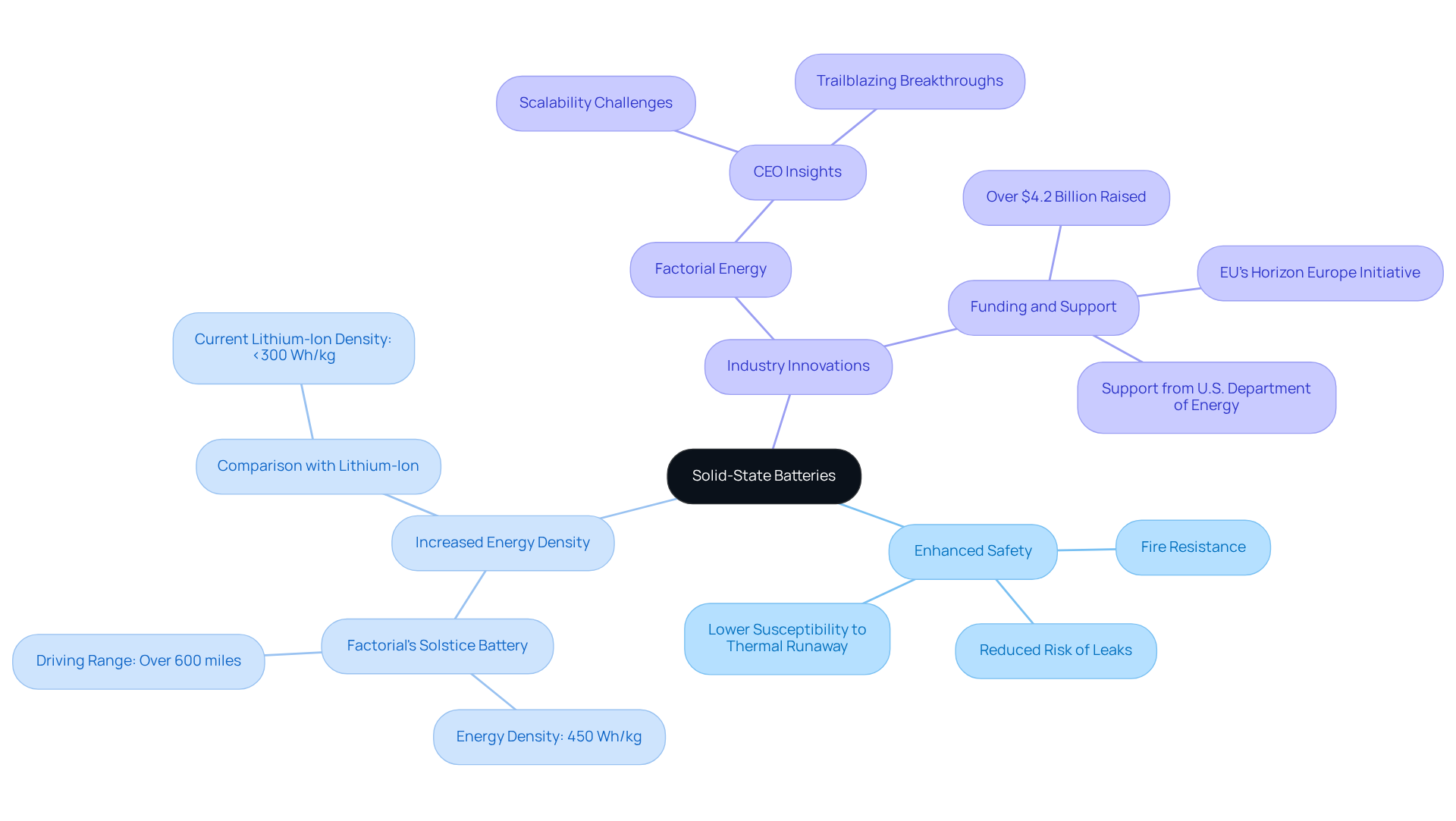
Lithium Iron Phosphate (LFP) Batteries: Safety and Longevity
Lithium Iron Phosphate (LFP) cells stand out due to their remarkable thermal stability and extended cycle life. Fire-resistant battery technologies, unlike other lithium-ion cells, exhibit a significantly lower tendency to overheat, thereby enhancing their safety profile. This characteristic is crucial for users who prioritize safety in fire-resistant battery technologies for energy storage solutions.
Additionally, LFP cells boast a longer lifespan, making them a cost-efficient choice for power retention applications. This is particularly relevant in renewable energy systems, where durability is not just beneficial but essential.
The combination of safety and longevity positions LFP cells as a superior option in the evolving energy landscape, particularly in the context of fire-resistant battery technologies.
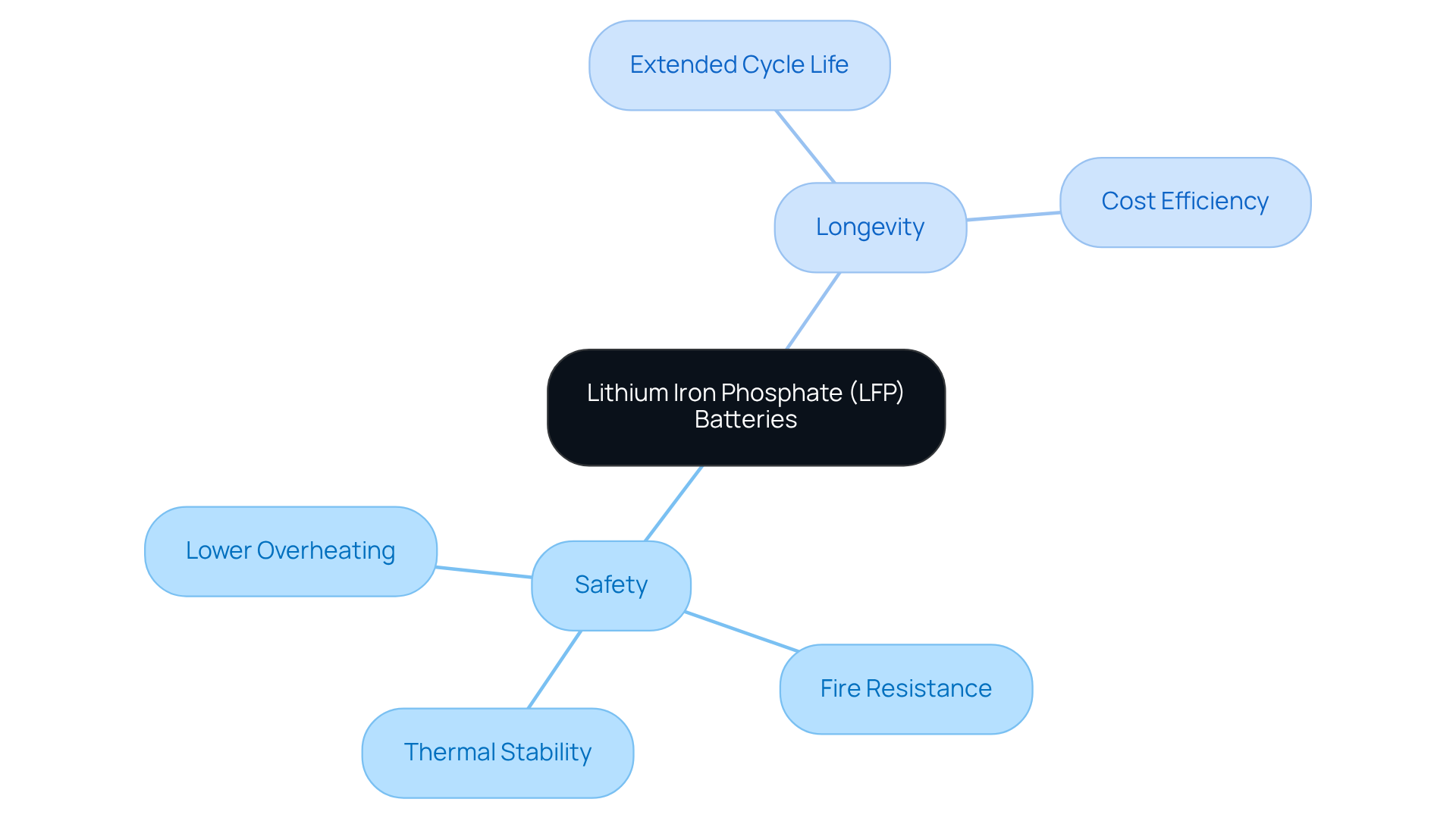
Nickel Manganese Cobalt (NMC) Batteries: Balancing Performance and Safety
Nickel Manganese Cobalt (NMC) cells represent a significant advancement in power retention technology, achieving a critical balance between performance and safety. With a cell voltage ranging from 3.6 to 3.7 V, these energy sources deliver high energy density and power output while upholding a commendable safety profile. The distinctive composition of nickel, manganese, and cobalt enhances thermal stability, which is essential for fire-resistant battery technologies to mitigate the risks of overheating and potential fires.
By 2025, improvements in thermal stability ratings for NMC cells have further solidified their suitability for demanding applications, including electric vehicles and grid solutions. Experts in energy storage technology assert that the thermal stability of NMC units is not merely a characteristic but a vital aspect, ensuring reliability in critical situations.
Elon Musk noted that the Tesla Powerwall, which utilizes NMC technology, is designed to increase the number of charge/discharge cycles, underscoring its importance in residential energy solutions. This emphasis on safety is highlighted by the historical context of NMC materials, which have undergone significant evolution since their inception, with ongoing research focused on optimizing performance through enhanced crystallinity and particle size distribution.
Notably, John B. Goodenough's groundbreaking work on lithium cobalt oxide in the 1980s laid the foundation for the advancement of NMC technology. The integration of advanced synthesis techniques, such as coprecipitation, hydrothermal treatment, and sol-gel processes, continues to enhance the thermal stability of NMC cells, establishing them as a preferred choice in the rapidly evolving field of power management.
In conclusion, advancements in thermal stability not only improve the performance of NMC systems but also play a crucial role in ensuring safety in energy storage applications that utilize fire-resistant battery technologies.
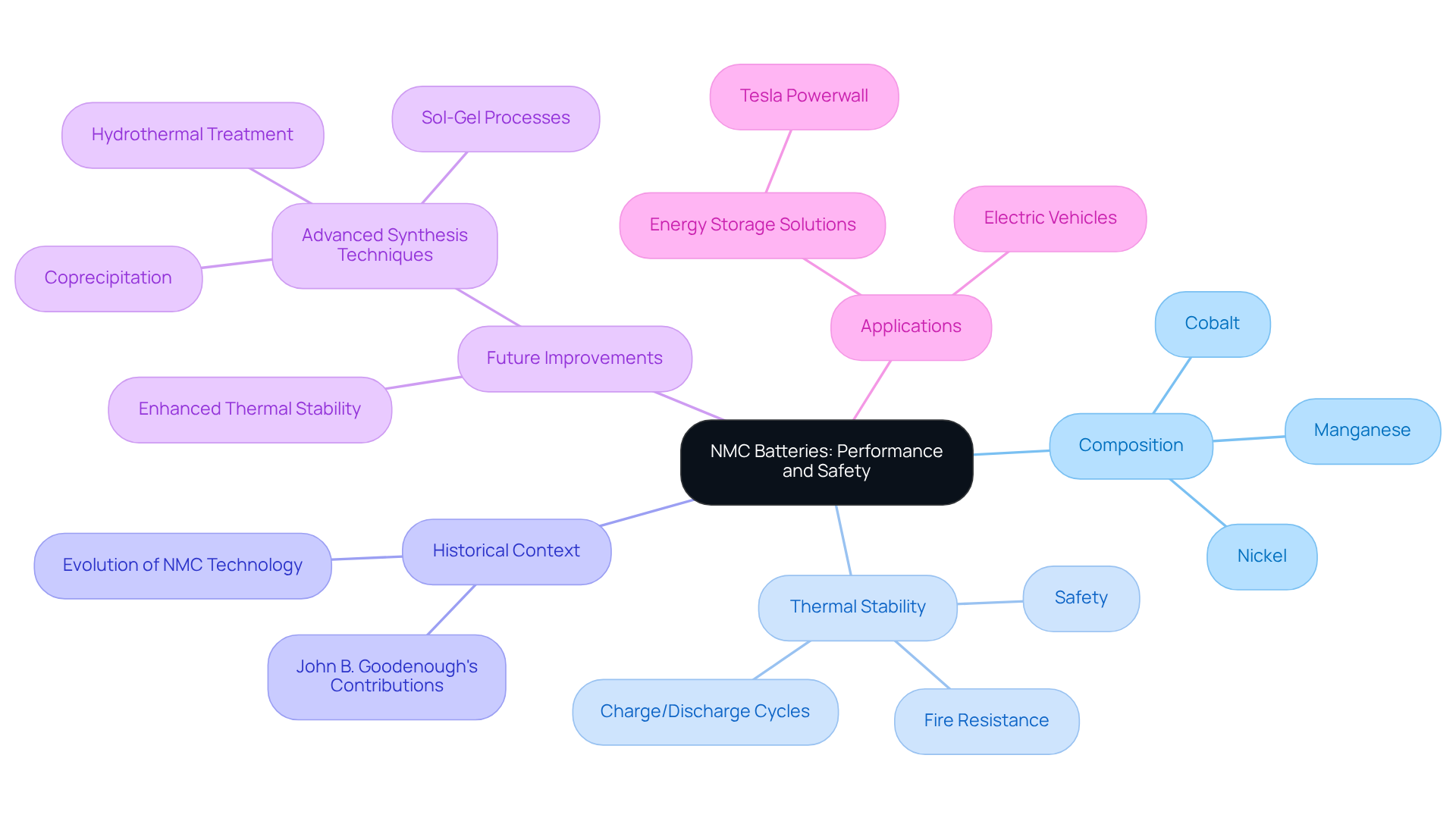
Thermal Management Systems in Batteries: Preventing Overheating Risks
Thermal control mechanisms are essential for maintaining optimal operating temperatures in energy storage units. These systems integrate:
- Cooling mechanisms
- Insulation
- Temperature monitoring technologies
These components are designed to prevent overheating. By effectively managing heat, these systems not only enhance the safety of energy cells but also improve performance, ensuring that energy storage solutions function efficiently even in demanding conditions.
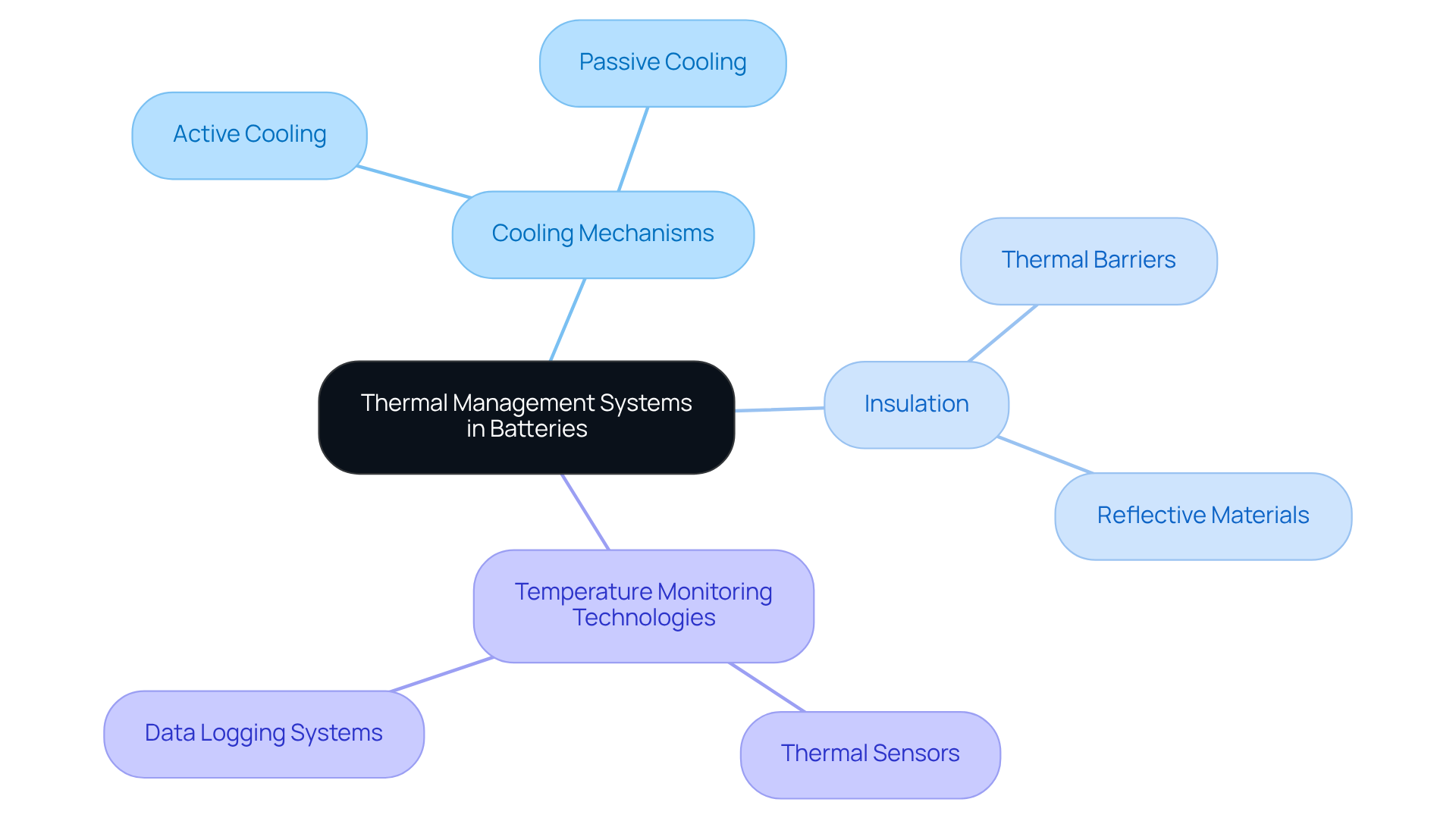
Graphene-Based Batteries: Revolutionizing Safety and Efficiency
Graphene-based energy storage devices stand at the cutting edge of technological innovation. They deliver exceptional conductivity and thermal management, significantly enhancing both safety and efficiency. These advanced power sources charge more rapidly and boast a longer lifespan compared to traditional lithium-ion units. As research continues to evolve, graphene power sources promise to revolutionize energy storage solutions, rendering them not only safer but also more efficient for a wide array of applications.
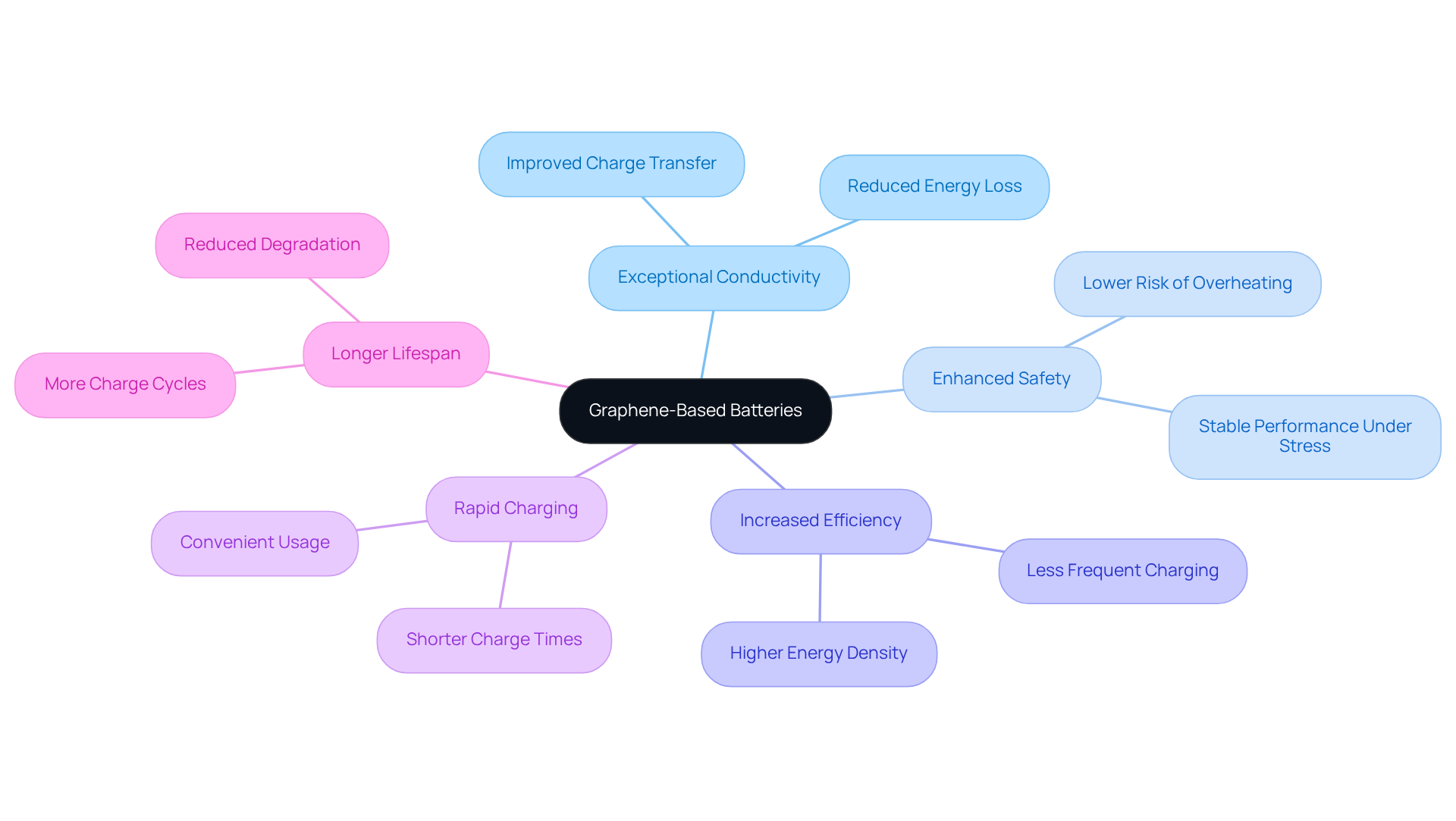
High-Temperature Batteries: Resilience in Extreme Conditions
High-temperature energy storage systems utilize fire-resistant battery technologies to withstand extreme conditions without compromising safety. These power sources excel in environments where conventional units may falter, particularly in industrial applications or regions with elevated ambient temperatures. Their robust design significantly reduces the risk of thermal runaway, thereby establishing fire-resistant battery technologies as a reliable choice for critical power storage needs.
In today's demanding energy landscape, the ability to maintain performance under duress is paramount. As industries evolve, the necessity for dependable energy solutions becomes increasingly evident. High-temperature energy storage, which includes fire-resistant battery technologies, not only meets this need but also sets a new standard for resilience and efficiency.
Are you prepared to enhance your energy storage capabilities? Consider the advantages that high-temperature systems offer:
- Increased safety
- Reliability
- Operational efficiency
By integrating fire-resistant battery technologies and other advanced solutions, you can ensure that your energy needs are met, even in the most challenging conditions.
In conclusion, high-temperature energy storage systems represent a vital advancement in power storage technology. Their ability to operate safely and effectively in extreme environments makes them indispensable for any organization looking to secure its energy future.
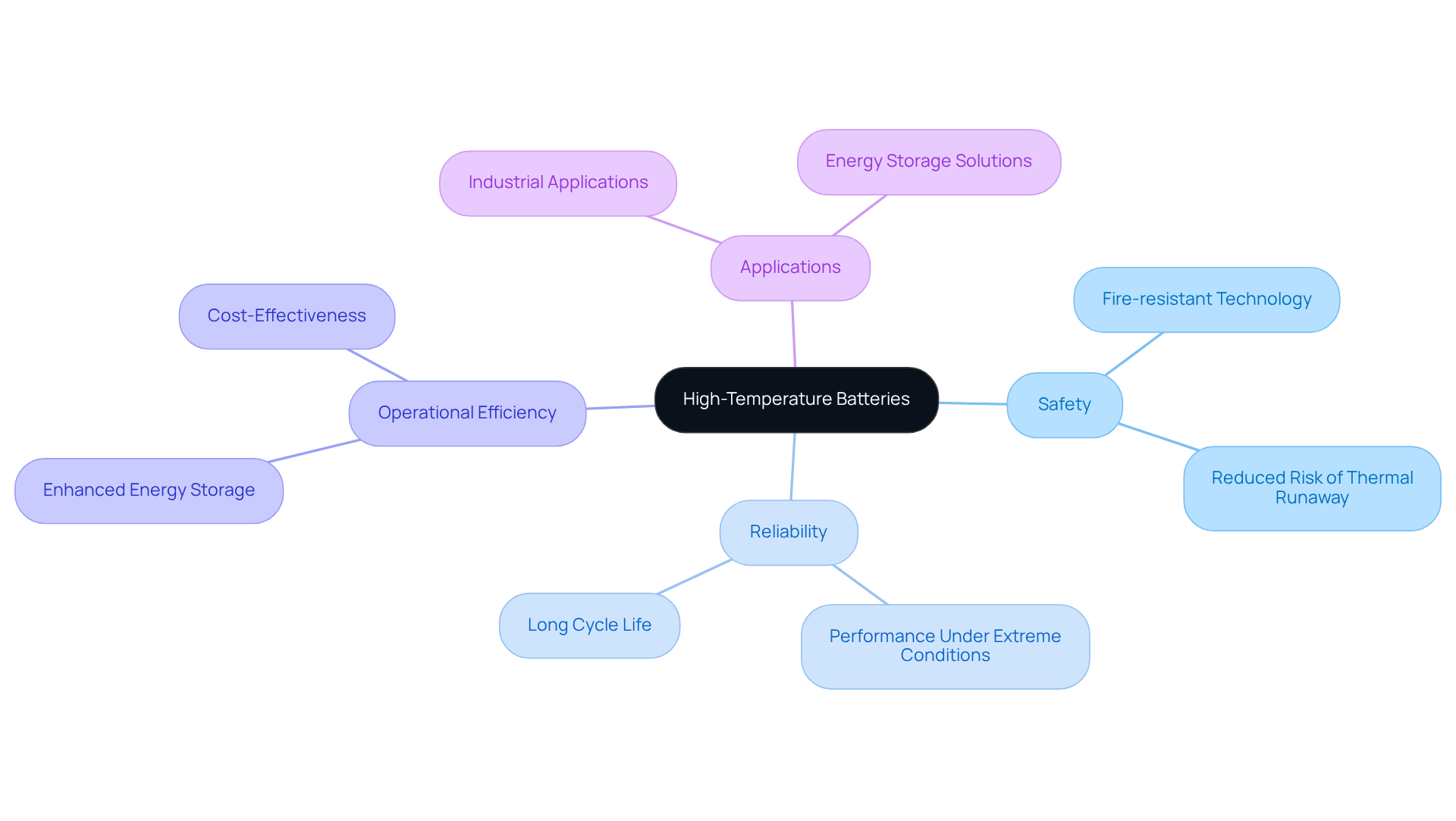
Modular Battery Systems: Flexible and Fire-Resistant Solutions
Modular battery frameworks exemplify adaptability and scalability, presenting an ideal solution for evolving power demands. These systems utilize fire-resistant battery technologies, such as lithium iron phosphate (LiFePO4) and flame-retardant polymers, significantly enhancing safety by mitigating the risks of thermal runaway and fire hazards. Their inherent flexibility facilitates rapid deployment and seamless expansion, catering to both residential and commercial energy storage needs.
In residential applications, these systems can be readily modified to accommodate increased power requirements from electric vehicles or home automation technologies. In commercial settings, modular frameworks can be integrated into existing infrastructure, providing backup power during outages and optimizing energy consumption during peak periods. Industry leaders emphasize that the modular approach not only meets current energy demands but also equips users for future growth, underscoring the importance of these solutions in a rapidly changing energy landscape.
As highlighted by a leading expert in energy storage, 'The flexibility of modular systems allows businesses to adapt to changing energy demands without significant upfront investment, making them a smart choice for the future.' This adaptability positions modular battery frameworks as a strategic investment for those looking to navigate the complexities of modern energy needs.
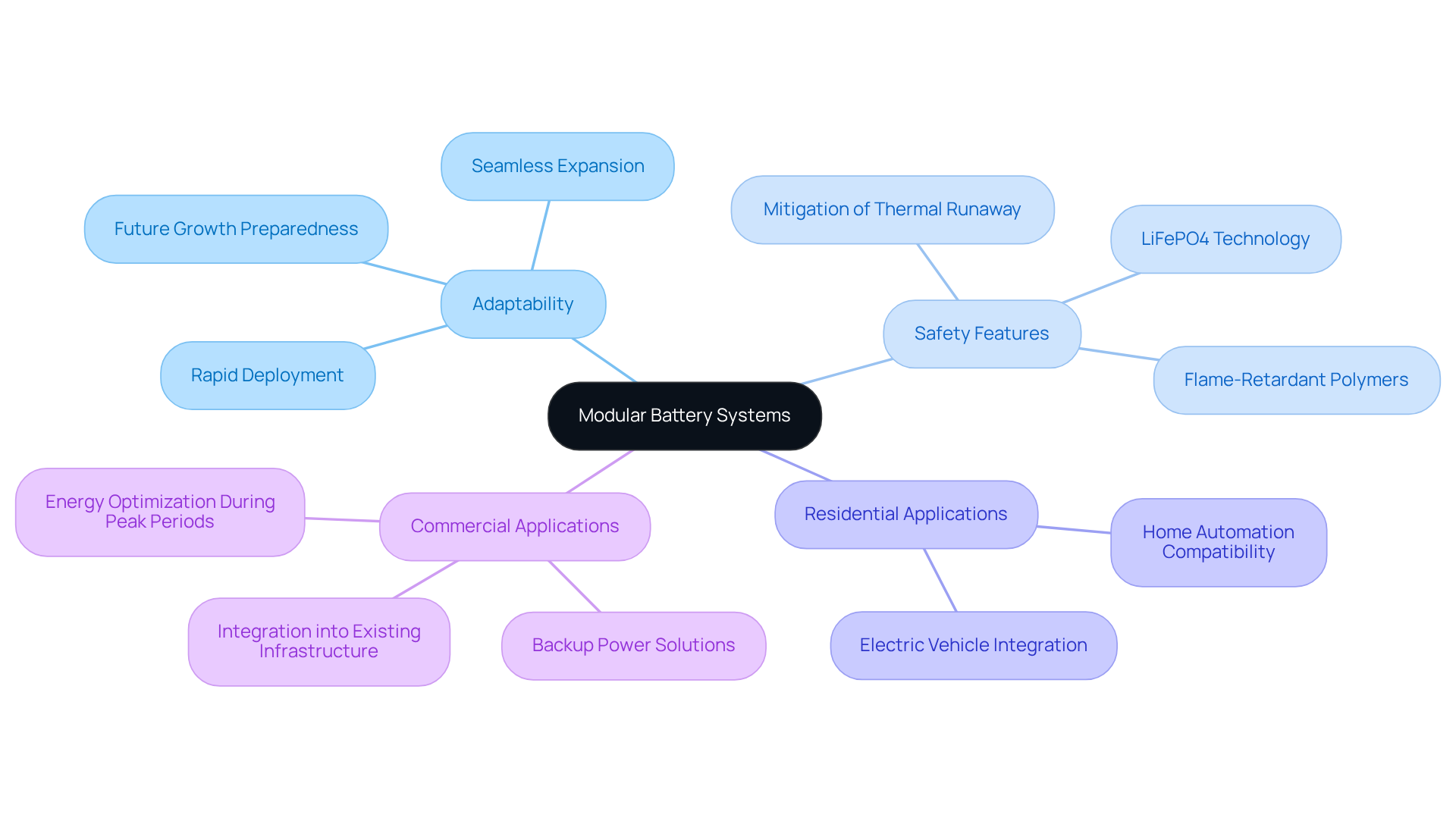
Polymer Batteries: Lightweight and Fire-Resistant Innovations
Polymer energy storage devices represent a significant advancement in energy technology, utilizing a solid polymer electrolyte that not only reduces weight but also enhances safety. These devices, which incorporate fire-resistant battery technologies, are less susceptible to leakage and thermal runaway, positioning them as a safer alternative to conventional lithium-ion cells. Their lightweight nature makes them particularly suitable for applications in portable devices and electric vehicles, where weight is a critical factor. By prioritizing safety and efficiency, fire-resistant battery technologies are paving the way for more reliable and effective energy solutions.
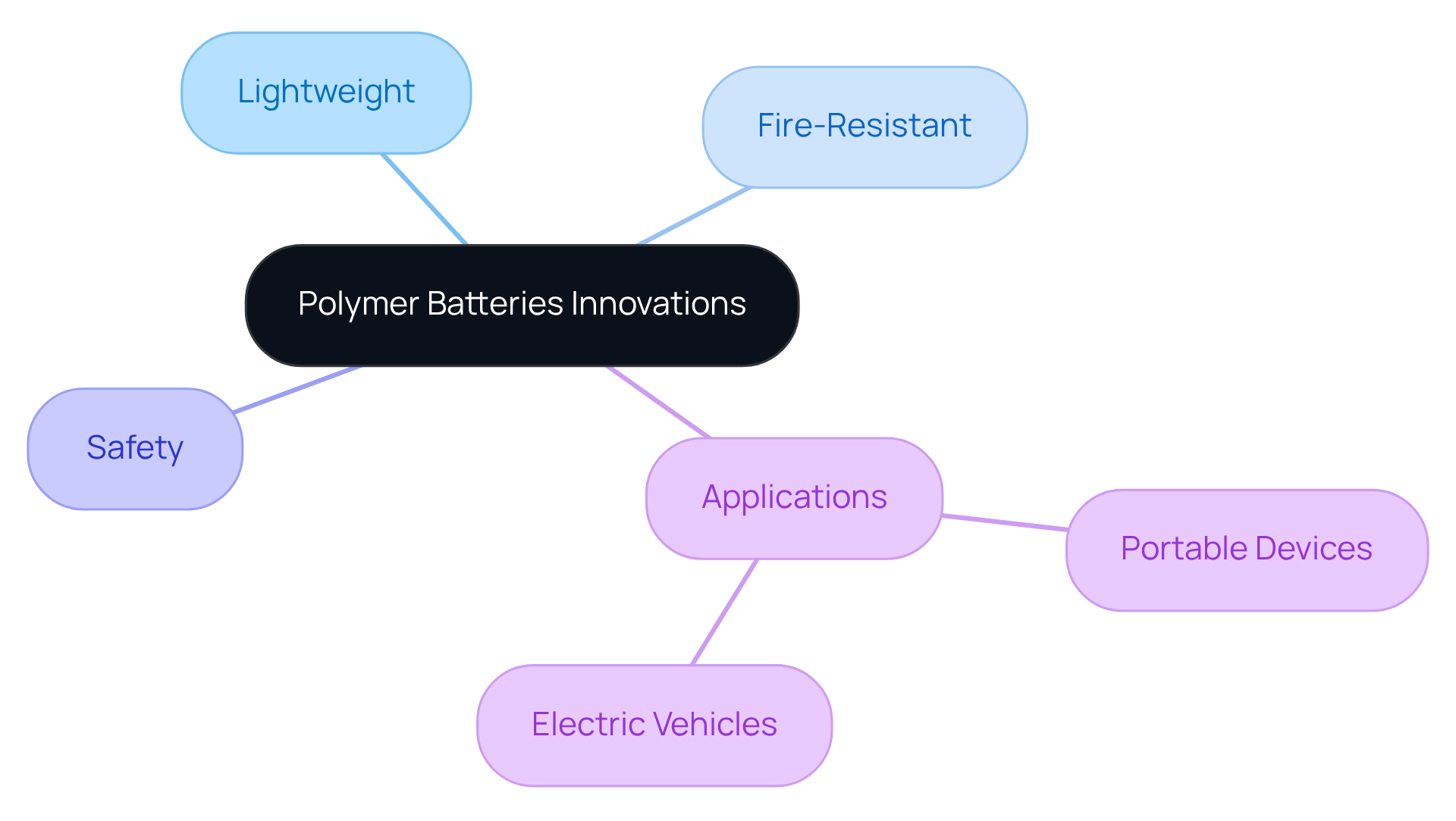
Smart Battery Management Systems: Enhancing Safety and Performance
Intelligent power management frameworks are indispensable in contemporary power retention solutions. They continuously monitor the state of charge (SOC), state of health (SOH), and state of function (SOF) of cell units, ensuring optimal performance while preventing overcharging and overheating. By employing sophisticated algorithms and real-time information, intelligent Battery Management Systems (BMS) enhance both the safety and efficiency of power systems, making them crucial for large-scale power management applications.
In 2025, advancements in smart BMS technology have significantly enhanced their capabilities, incorporating artificial intelligence for predictive analytics and proactive adjustments. This innovation empowers BMS to anticipate potential issues, optimizing battery performance and extending longevity. Furthermore, the integration of cloud connectivity and Internet of Things (IoT) features not only facilitates remote monitoring and control but also bolsters cybersecurity strategies that protect resource data from potential threats.
The practical applications of intelligent BMS are evident across a spectrum of power reserve solutions, from residential setups to extensive grid-level installations and electric vehicles (EVs). These systems not only enhance the reliability and efficiency of power storage but also enable the integration of renewable sources such as solar and wind. By effectively balancing supply and demand, smart BMS contribute to grid stability and resilience, rendering them indispensable in the transition to a sustainable energy infrastructure.
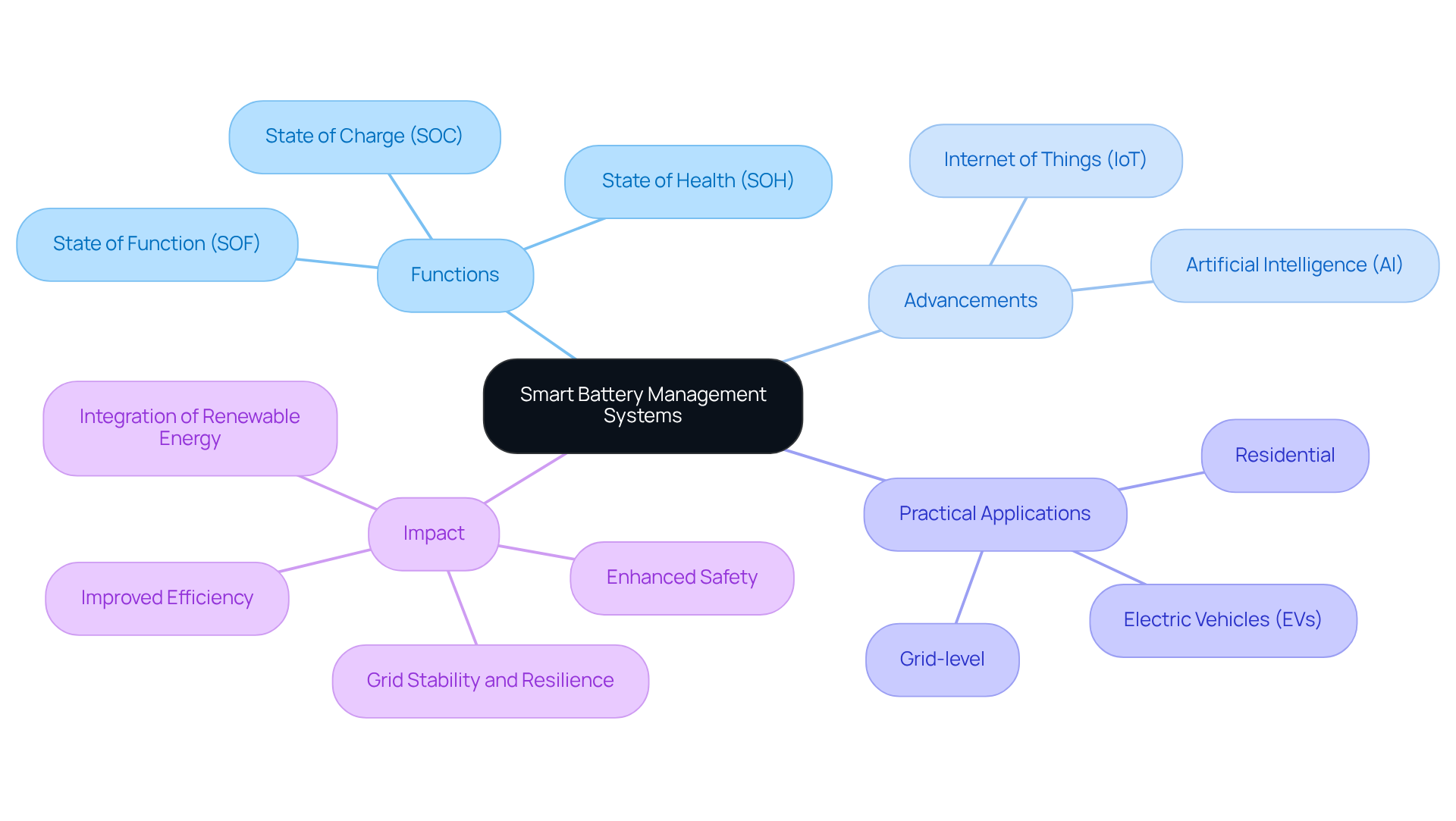
Conclusion
The exploration of fire-resistant battery technologies signifies a transformative shift in energy storage safety. Innovative designs such as solid-state, lithium iron phosphate, and modular systems not only mitigate risks associated with overheating and thermal runaway but also enhance overall performance and longevity. The emphasis on safety in energy storage solutions is paramount, as it directly influences the reliability and efficiency of power systems across various applications.
Notable insights from this discussion underscore the distinct advantages of each technology. Solid-state batteries significantly reduce thermal incidents, while lithium iron phosphate cells extend cycle life. Additionally, nickel manganese cobalt batteries offer a balanced approach to performance and safety. The integration of thermal management systems and smart battery management technologies further emphasizes the necessity of proactive measures in maintaining optimal operating conditions for energy storage devices.
As the energy landscape continues to evolve, embracing these fire-resistant technologies becomes critical for future-proofing energy storage solutions. Organizations and developers are urged to invest in these innovations, not only to enhance safety but also to optimize energy efficiency and reliability within their operations. The adoption of advanced battery technologies is not merely a strategic move; it is an essential step towards securing a sustainable energy future.
Frequently Asked Questions
What solutions does Harbinger Land provide for energy storage projects?
Harbinger Land offers advanced title research solutions specifically tailored for power retention projects, leveraging AI-powered title research software and GIS mapping services to ensure compliance with legal requirements.
How does Harbinger Land's GIS mapping enhance project management?
Harbinger Land's GIS mapping capabilities provide enhanced visibility into projects, allowing for efficient decision-making by integrating real-time data, which helps clients assess potential issues and opportunities quickly.
What advantages do solid-state batteries offer over traditional lithium-ion batteries?
Solid-state batteries utilize fire-resistant technologies with a solid electrolyte, significantly reducing the risk of leaks and fires, and have shown a 50% reduction in thermal runaway incidents compared to traditional lithium-ion batteries.
What challenges do solid-state batteries face in commercialization?
The main challenge for solid-state batteries is scalability, as highlighted by industry leaders like Factorial Energy's CEO, Siyu Huang.
What are the key benefits of Lithium Iron Phosphate (LFP) batteries?
LFP batteries are known for their remarkable thermal stability, extended cycle life, and lower tendency to overheat, making them a safer and more cost-efficient choice for energy storage applications, especially in renewable energy systems.
Why are safety and longevity important in energy storage solutions?
Safety is crucial to prevent overheating and potential hazards, while longevity ensures durability and cost-effectiveness, particularly in renewable energy systems where reliable performance is essential.
List of Sources
- Solid-State Batteries: Enhanced Safety and Energy Density
- Press Center - EV Solid-State Battery Validation Accelerates in the U.S. and Europe, Mass Production Expected to Gradually Begin by 2026, Says TrendForce | TrendForce - Market research, price trend of DRAM, NAND Flash, LEDs, TFT-LCD and green energy, PV (https://trendforce.com/presscenter/news/20250313-12516.html)
- Solid-State Batteries Are In ‘Trailblazer’ Mode. What's Holding Them Up? (https://insideevs.com/news/749893/evs-solid-state-batteries-near-finish-line-roadblocks)
- Nickel Manganese Cobalt (NMC) Batteries: Balancing Performance and Safety
- Lithium nickel manganese cobalt oxides - Wikipedia (https://en.wikipedia.org/wiki/Lithium_nickel_manganese_cobalt_oxides)
- High-Temperature Batteries: Resilience in Extreme Conditions
- Engineers develop safe and long-cyclable lithium metal battery for high temperatures (https://techxplore.com/news/2024-07-safe-cyclable-lithium-metal-battery.html)
- Modular Battery Systems: Flexible and Fire-Resistant Solutions
- 60 Quotes About the Future of Renewable Energy (https://deliberatedirections.com/renewable-energy-quotes)
- Smart Battery Management Systems: Enhancing Safety and Performance
- The Role of BMS Battery Systems in Enhancing Safety and Efficiency | Enerlution (https://enerlution.com.cn/a-news-the-role-of-bms-battery-systems-in-enhancing-safety-and-efficiency.html)




